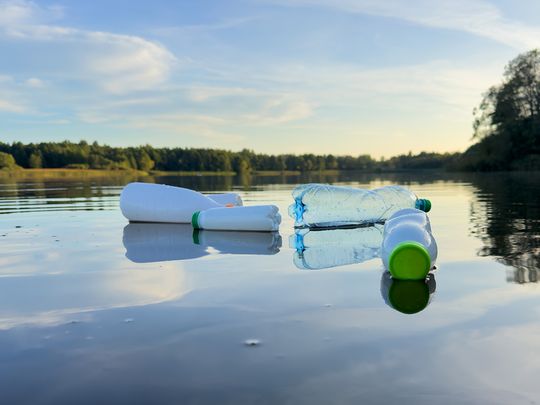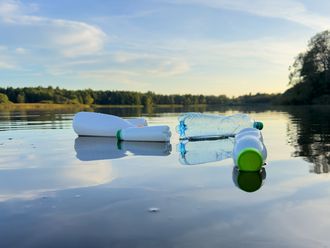
Many would remember seeing their mother carry a cloth bag or a woven basket for shopping. However, in the early 1970s, plastic shopping bags became the rage in European countries.
Soon, these were omnipresent worldwide, as companies manufacturing plastic bags aggressively marketed the single-use product, terming it superior to paper or reusable bags.
Plastic is incredibly durable and does not decompose easily. This means it persists in the environment for centuries, accumulating in landfills and natural habitats.
Annie Leonard, the executive director of Greenpeace United States, remarked, “There is no such thing as ‘away’. When we throw anything away, it must go somewhere.”
So where does the plastic go?
The answer is — ‘All the plastic that has ever been produced and ended up in the environment, is still present there in one form or another.’
Plastic pollution is widespread — from the ocean’s depths to the polar ice caps and from the summit of Mount Everest to the residential drains.
From packaging to everyday items, plastic products have led to significant environmental degradation and health concerns for all living beings.
The wake-up call
While opposition to single-use plastic began in the 1980s the discovery of the Great Pacific Garbage Patch in 1997 changed how plastic was viewed.
Since the breakdown of larger plastic debris results in tiny plastic particles, microplastics are found in rivers, oceans, and the air we breathe.
It was realised that a significant amount of plastic waste ending up in the oceans posed a severe threat to marine life. Turtles, seabirds, and fish, mistake plastic for food and consume it, leading to it entangling in the body and proving fatal. Ingested by marine organisms, it enters the food chain, potentially affecting human health.
Not just that, plastic leaches harmful chemicals into the soil and groundwater, affecting plant and animal life. This contamination disrupts the ecosystem and reduces biodiversity.
Its production and disposal contribute significantly to greenhouse gas emissions (GHGs), exacerbating climate change. The incineration of plastic waste releases toxic gases and pollutants into the atmosphere, as it contains chemical additives including phthalates and bisphenol A (BPA), which seep into food and beverages.
These chemicals disrupt the endocrine function and are linked to reproductive and developmental problems.
Burning plastic waste releases harmful pollutants, including dioxins and furans, which cause respiratory problems and cardiovascular diseases. Similarly, accumulated plastic waste, a breeding ground for disease-carrying insects such as mosquitoes, increases the risk of vector-borne diseases.
Recent studies have shown microplastics in human tissues, including the lungs, liver, and bloodstream. The long-term health effects of these particles (still being studied) could be detrimental.
Setting precedents
Rwanda became a shining example as the first country to claim the title of ‘plastic-free’ in 2008. The government strictly enforces the plastic bags and packaging ban, and the guilty are penalised.
Similarly, Bangladesh became the first country to ban thin plastic bags in 2002 after noting that these played a key role in clogging drainage systems during disastrous flooding.
As some other countries followed suit, in 2018, the United Nations Environment Program (UNEP) observed that out of 192 countries, 127 enacted some form of national legislation to address the problem of plastic bags.
The same year, India hosted #BeatPlasticPollution as the theme of World Environment Day. Since then, governments have pledged to tackle plastic waste. ‘If you can’t reuse it, refuse it’, is the mantra.
Recently, the United Arab Emirates (UAE) declared a total prohibition on single-use plastic bags. The ban will extend to plastic products including styrofoam food containers and single-use cups, stirrers, straws, table covers, and cotton swabs.
Sikkim is a plastic-free state in India, whereas Dabur is the first Indian consumer goods company to achieve this landmark. Yearly, it collects, processes, and recycles the same amount of plastic waste as it sells in product packaging, becoming a ‘Plastic Waste Neutral’ enterprise.
Figures at a glance
Solid waste output has grown from 25 gigatons (25 billion tons) in 1990 to 86 gigatons in 2020 — and a projected 140 gigatons by 2050. The expansion exceeds population growth and results in a disposable-goods system, which combines short-term use and long-term environmental harm.
Importantly, while half of all plastic production is for single-use, only a fraction (14 per cent) of the plastic waste is recycled. Of that, only 2 per cent is ‘effectively recycled’ and converted into useful items. Most of it is ‘downcycled’ into something less meaningful than before, and goes to a landfill or the ocean.
Experts point out that instead of devoting resources to waste removal and treatment, the focus should be on eliminating waste.
Recycling and reuse strategies
• Minimise usage of single-use plastic.
• Opt for reusable items like cloth bags, metal straws, and glass.
• Repurpose items including plastic bottles as planters or storage containers.
• Encourage the development and use of biodegradable plastic and alternative materials.
• Segregate and recycle plastic waste.
• Ensure that plastics are cleaned and sorted to improve recycling.
• Support initiatives that promote a circular economy, where products are designed for reuse and recycling.
• Organise or participate in community clean-up drives and awareness campaigns.
• Educate others about the importance of reducing plastic waste and the benefits of recycling.
Such steps can significantly reduce pollution’s environmental and health impacts and provide a sustainable future. A reuse-based system will reduce humanity’s ecological footprint and create lucrative economic sources.
Roz Savage, environmental advocate and writer said, “It cannot be right to manufacture billions of objects that are used for a matter of minutes, and then are with us for centuries.”
Therefore, it makes sense to eradicate plastic before it destroys planet Earth.
(Next week the author will discuss climate change — A health issue)
Dr Abdullah Belhaif Al Nuaimi is Chairman of the Advisory Council of the Emirate of Sharjah










